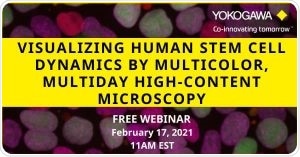The upcoming webinar 'Visualizing Human Stem Cell Dynamics by Multicolor, Multiday High-Content Microscopy' will take place on February 17, 11 AM EST / 5 PM CET.

Professor Dr. Rafael Carazo Salas of the University of Bristol’s School of Cellular and Molecular Medicine will describe multicolor, multiday high-content microscopy pipelines that his research group has recently developed. These high-content microscopy pipelines are used to visualize the dynamic cell fate changes of human Pluripotent Stem Cells (hPSCs).
The integrated experimental and computational approaches that his group has established will be of focus. He will also talk about novel “live” reporters of cell fate and multi-reporter hPSC lines generated by CRISPR/Cas9. Attendees from the high-content imaging community can expect to learn about exciting research such as visualizing how hPSCs proliferate and undergo early differentiation in vitro by high-content microscopy.
Molecular networks and processes
Dr. Carazco Salas’ group seeks to better understand the molecular networks and processes that control cellular growth, division, and differentiation. They have actively pioneered technologies to study how pluripotency and differentiation are controlled using human embryonic stem cells and induced pluripotent stem cells. Their research goal is to glean how to specifically, efficiently, and safely program heterogeneous populations of stem cells for therapeutic applications.
Better results with Yokogawa’s CellVoyager
Visualizing the complex spatiotemporal dynamics of human stem cells is key to improve our understanding of how to robustly engineer differentiated tissues for therapeutic applications. Stem cells proliferate and make cell fate decisions. Using the Yokogawa CV7000, Dr. Carazo Salas was able to translate visualizing spatiotemporal dynamics of human stem cells to a high-content platform. Using a spinning disk confocal microscopy allows for long term imaging of these live cells due to low phototoxicity and optical sectioning of thick tissue.
What can pluripotent stem cells be used for?
Pluripotent stem cells are cells with superpowers. Being attacked, they use their capacity to self-renew. They do so by dividing. After dividing, they change their form. They develop into the three primary germ cell layers which you can find in the early stage of an embryo. From there, they can transform into different types of cells in the human body. Examples of pluripotent stem cells are embryonic stem cells and induced pluripotent stem cells.
For fighting diseases, pluripotent stem cells have enormous potential. You could potentially create any cell or tissue to encounter a specific disease, from cancer to diabetes.
Another, not yet realized vision is to customize pluripotent stem cells to match one’s individual’s genetic perfectly. With this achievement, patients could receive cell and tissue transplants without rejection issues. They could get rid of taking life-long immune-suppressing drugs.
Insights about Pluripotent Stem Cell Research
Be sure to attend this fascinating discussion to learn more about experimental and computational pipelines that enable monitoring single-cell fate dynamics and novel “live” reporters of hPSC cell fate. Register Here.